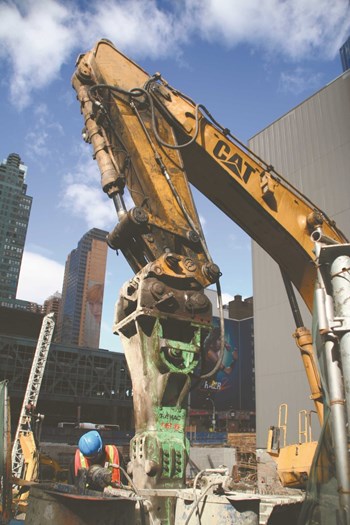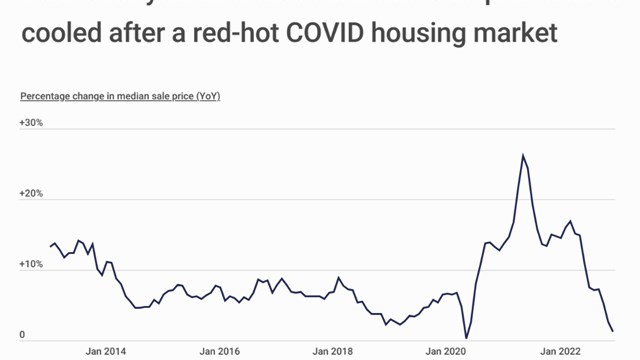
It seems like only yesterday when “condo-mania” was sweeping many neighborhoods, and developers couldn’t wait to build one condo development after another. Every other week or so, another open house was held, and developers competed to advertise their buildings’ attractive features, from childrens' rec rooms to free parking spaces to fully decked-out gyms.
But 2009 will always be known as the year that the economic recession became a full-blown disaster, with a record number of spectacular failings and near-failings in the financial industry. In the world of real estate, the downturn began even earlier, with the mortgage crisis. Many economists are predicting an upturn (however slight) this year, but most agree that it’s still too soon to know.
The economic storm has had a profound effect on residential development in New York City. Some new buildings are being completed, but plans for countless others have been scotched, or are standing half-completed in muddy construction pits. Other buildings that were only recently completed before the crash are having serious trouble selling apartments.
Not a Ghost Town
This is not to say that new development has come to a complete standstill, of course. For example, L&M Development Partners is expected to finish work on the Columbia-Hicks mixed-income development in Brooklyn this year, which includes both for-sale and rental units. Another one of the firm’s developments that is scheduled to open this year is 540 West 28th Street, also known as +Art, a luxury condo development in Manhattan's West Chelsea gallery district. Perhaps the firm’s most innovative development is P.S. 90 in Harlem, which we will describe in detail later. And in Brooklyn again, BFC Partners has completed the Toren affordable condo development, which is now ready for occupancy.
In an article in January in The Real Deal, writer David Jones mentioned that The Related Companies restarted construction in the fall on a high-rise at 440 West 42nd Street, which will include condos, rentals, a hotel and a theater. An article in The Real Deal also mentioned that a joint venture between the Durst Organization and Sidney Fetner Associates closed a deal in September to buy a 16-story building from Mt. Sinai Hospital and convert it into condos; and that developer Young Woo acquired two Downtown office towers at 70 Pine Street and 72 Wall Street with the intention of converting them into condos as well.
Those projects aside however, Corcoran Sunshine Marketing Group is not bullish on new construction—at least not just yet. “Construction financing is very difficult for developers to obtain,” says the firm’s president, Kelly Kennedy Mack, “so little new product is coming to market. This is injecting buyers with a renewed sense of urgency as their options to own a new home become increasingly limited.”
Her firm and others like it, according to Mack, are taking a greater focus on project takeovers—meaning the situation that ensues when a development takes on a new marketing and sales agent to meet new demands. For example, Corcoran Sunshine was recently appointed as exclusive marketing and sale agent for 350 West Broadway, a Soho luxury building that is being developed by RFR Holding.
What are some of the more noteworthy projects going up or opening for occupancy? Mack names several. One is the Dillon at 425 West 53rd Street, developed by SDS Procida and Designed by Smith Miller & Hawkinson Architects. The building, which contains 83 condo units selling from approximately $732,000 on up, has “a dynamic folding glass façade that has received an award from the American Institute of Architects.”
Mack also mentions the First Quarter, an 18-story new condo on 14th Street designed by Perkins Eastman with residences priced from the mid-$500,000's and up; and three new other buildings that the firm is representing, 535 West End Avenue, 46 Irving Place, and 311 East 11th Street or Village Green.
Stephen Kliegerman, executive director of Halstead Development Marketing, when asked to name some new-and-noteworthy projects, also mentions P.S. 90 on West 148th Street, a redevelopment of a turn-of-the century public school building slated to be finished this summer. Although the building has been redeveloped for condos, its developers have kept all the original gargoyles and ornate façade decorations.
Kliegerman also mentions 2280 Frederick Douglass Boulevard in Harlem; Central Park Plaza at 1845-1851 Adam Clayton Powell Boulevard; and the Toren condominium (see above) in Brooklyn, a “green” building designed by Skidmore Owings & Merrill, which he called “perhaps Brooklyn’s finest and most recognizable piece of modern new construction architecture.” As for +Art, near the High Line, Kliegerman points out that it's “one of the very few new developments coming to market in Manhattan with a 421-a tax abatement in 2010.”
Stalled Out
But juxtaposed against these attractive new developments must be the large numbers of stalled, under-funded or under-occupied condos in the city, a subject covered in a previous Cooperator article by this writer. Figures vary, but Marolyn Davenport of the Real Estate Board of New York (REBNY) told The Cooperator late last year that “there are over 500 buildings that have been stopped entirely because of lack of financing.” Assemblyman Hakeem Jeffries said that 65 condo buildings in Central Brooklyn alone are “troubled.” The source most people use to find out the exact, most current figures on foundering developments is the regularly updated “Stalled Construction Sites” list on the New York City Department of Buildings’ website: www.nyc.gov/html /dob/html/guides/snapshot_report.shtml. Of course, not all the buildings listed are condo or co-op developments and those details aren’t provided, but a little research can find that out. As of March 15, for example, 575 buildings were listed.
In response to this situation, the city has passed legislation that lets developers of stalled projects maintain their sites with a safety program while their building permits remain active, so that when the market does pick up, they can begin work again without having to apply for a new permit. Tellingly, about 500 projects are taking part in the program, says Mike Slattery, REBNY's senior vice president.
Even most of those condos that are being completed now and being put on the market are mainly those that were already under way at this time last year, says Slattery. “If they’re coming in a month or two, this probably means they were well under way at this time last year and had financing, and made the prudent decision to get going.” By contrast, Slattery reports that in October and November 2009, no permits were issued for Manhattan at all.
Developers and managers of condo buildings that are already completed but that aren’t selling, or that are selling more slowly than would be desirable, are employing different strategies. Some, understandably, are lowering prices. Some even have gone so far as to offer cars to buyers, such as Windows on 123 in Harlem, which enticed prospective purchasers with SmartCars, and One Brooklyn Bridge Park, which offered new Audis to new buyers last year.
2nd Avenue Subway & the High Line
Two major changes in Manhattan— the building of the Second Avenue Subway on the Upper East Side and the development of the High Line elevated park in Chelsea—are also having an effect on condo and co-op development.
What seems—at least to some folks— like endless construction for the Second Avenue Subway line also seems to be having a negative effect on surrounding real estate. Marcelo Ronchini, one of the founders of the Second Avenue Business Association, says, “I’ve definitely heard about this from many people. I don’t know about new buildings, but there’s one building, 1760 Second Avenue, where there hasn’t been an apartment sold in a year.” That building, known as Chartwell House, was built in 2001 and has 154 units, and Ronchini puts the blame for its stagnant sales squarely on the disruptions from ongoing construction.
While acknowledging that there are problems stemming from the construction process and uncertainty over when the line will actually open, Corcoran Sunshine's Mack has a more positive take on the subway construction. “Forward-looking developers have already recognized the investment potential of the Second Avenue subway line,” he says. “When completed, it will bring a new level of access to the East Side that I believe will increase property values and spur further development.”
As examples of developments that will benefit from the subway, he cites 525 East 72nd Street, known as Miraval Living, which features an elaborate gym-fitness center, and The Laurel on 67th Street, which specifically mentions “the convenience of the nearby upcoming Second Avenue subway” on its promotional website.
By contrast, reaction to the preservation and redevelopment of the High Line on Manhattan's Far West Side has been almost unanimously positive. Katie Lorah, a spokeswoman for Friends of the High Line, the group responsible for rehabilitating the former freight railway into an elevated park, says of the relationship between residential development and the High Line: “It’s complicated—but as the project proceeded, the space became more desirable for development.”
The creation of a special zoning district, she says, encouraged residential development. Among its provisions were one that transferred air rights from the old rail structure itself to neighboring buildings, adding more area for them. Not only condo buildings, but at least two hotels followed. So far, only the portion of the High Line below 20th Street is open, but next fall, the next section, stretching north to 30th Street is expected to open as well, according to Lorah. The Friends and others are also trying to begin a High Line Improvement District to help fund maintenance on the structure. Last year, the Caledonia condos on West 17th Street and the developers of a yet-to-be-finished condo on 10th Avenue applied for direct access for their buildings to the park, but those moves have been delayed as the city insists that these access points also be available to the public.
Naturally, all of this did not happen in a vacuum. “The Chelsea neighborhood has always been a desirable area with a strong residential character already, and changing manufacturing zoning to residential was a significant change that brought about residential development [near the High Line],” says Slattery.
Mack and Corcoran Sunshine, which represents the Chelsea Modern, located steps from the High Line’s 18th Street entrance – calls the High Line “the crown jewel of West Chelsea."
More Conversions
Overall, today’s economic situation has focused attention on conversion of existing buildings as well as new development. As examples of conversions that Halstead is working on, Kliegerman mentions Central Park Plaza on Adam Clayton Powell Boulevard, 905 West End Avenue, 220 West 93rd and 865 U.N. Plaza off of First Avenue.
“As the availability of construction financing is still difficult, “ he says, “I believe we will see more conversions in the near future. Additionally, as mortgages come due on rental properties, landlords may choose to convert rather than taking on additional personal guarantees in order to obtain financing.”
Slattery, though, feels the advantage of conversions has its limits. “Although the developer may save money by having only to renovate rather than to build anew, he says, “the challenge is selling these units in today’s market.”
While there are some indications that the economy is taking baby steps toward recovery, and sales numbers aren't at the standstill they were a year ago, most industry observers agree that it's going to be some time before Gotham is again bristling with construction cranes as it was in the pre-recession building boom. With financing tough to secure and buyers acting more cautiously, it seems that the building, buying, and flipping frenzy that characterized the last few years has calmed. But then again, this is New York – the city may doze, but it never really sleeps.
Raanan Geberer is a freelance writer, reporter, and editor living in New York City.






Leave a Comment